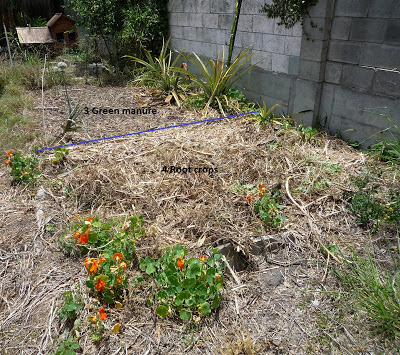After a delayed start to getting the garden going after winter and an eight week stint living away from home, I've finally made the time to organise the vegie garden into a six bed crop rotation system. Now that I've divided the beds up and have a written plan I'll have more idea of where I've planted things instead of the usual I think I put that there last year, and mayyybe over there the year before.
Aside from organisation the other main reason for establishing the crop rotation was to help control pests and diseases. Last year I had to lie two beds fallow for a few seasons due to nematode problems. This really put a dent in my garden's productivity and left me with little space to use for vegies. The rotation should see new insusceptible crops move into a bed that potentially has a build up of a disease or pest such as nematodes. Another bonus of rotating crops is that the soil doesn't become depleted of a particular set of nutrients that the crop requires. Heavy feeders can be rotated with light feeders and different nutrients are used by each crop successively. The addition of a green manure crop in the rotation will ensure I have a bed resting and recharging its nutrients before a heavy feeding crop.
The one downside I see to crop rotation is that it doesn't leave much room for companion planting, which is something I've been attempting previously. To get around this I plan to find the companion plants that don't fit neatly into the rotation system and plant them at the end of rows and between plants where I've left too much spacing.
Here's a sketch of the rotation that I've planned based on the outline provided in Annette McFarlane's book Organic Vegetable Gardening:
The rotation beds aren't all the exactly the same size but they measure roughly 3x2m each. Each large bed has been divided to accommodate two rotations (of 3x2 each) and the long garden bed down the side fence will have dimensions of 12m x1m which has again been divided into two sections 6m long.
The final bed sizes aren't complete as yet and most will need extending to some degree. The corn and cucurbit bed will be the most work as it's an extension of the bed along the fence. Although I've had a few compost piles on that spot over the years, I'm thinking of trying a no-dig bed for this one as we have hard clay soil which is very dry at the moment due the lack of rain and will be too hard to dig.
The beds have mostly already been used for a while so I've started planting them out with their respective crops and will extend the beds as needed.




No comments:
Post a Comment
Thanks for leaving a comment or question, they will be published as soon as possible after review to avoid spam. This usually takes less than a day.